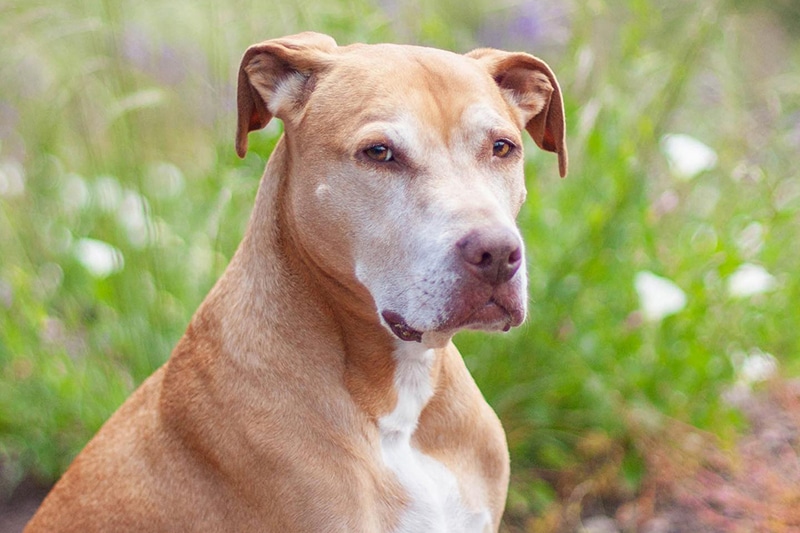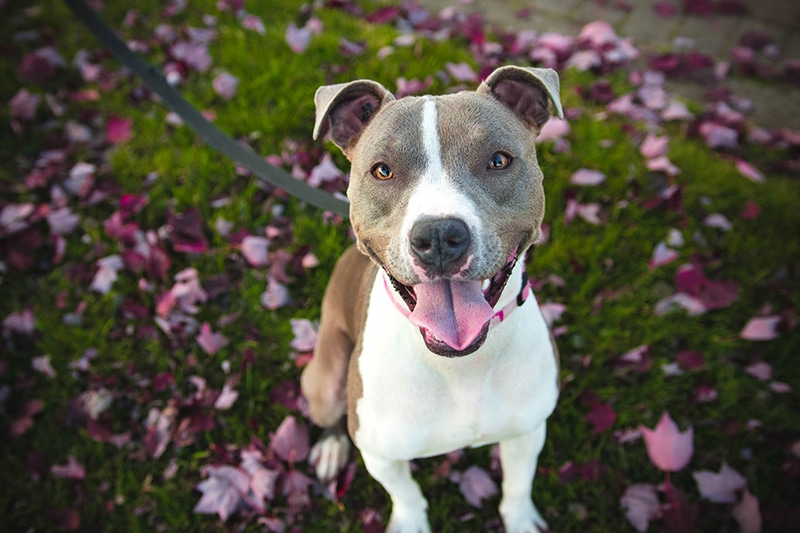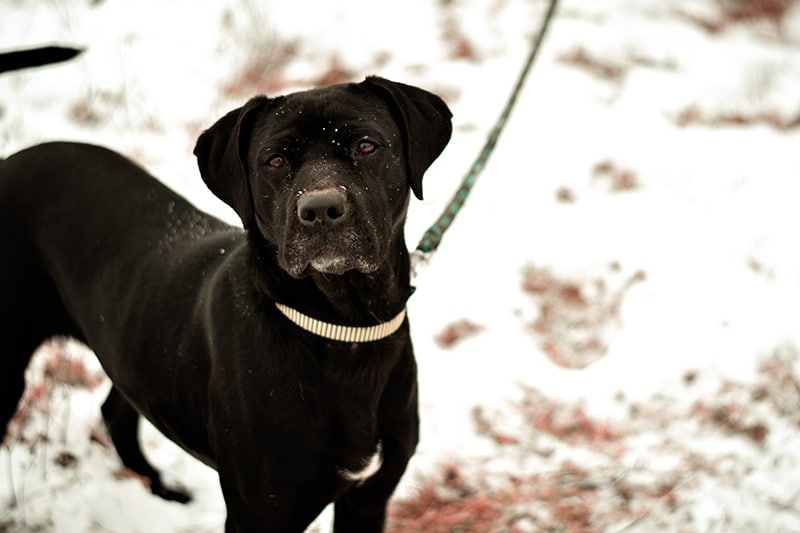The Pitbull Blue Heeler mix is a medium-sized mixed-breed dog, mixture the American Pitbull Terrier and the Australian Blue Heeler. The American Pitbull has long been a stalwart family pet in the United States, meanwhile the Australian Blue Heeler is a hunting dog established in Australia in the early 19th century.
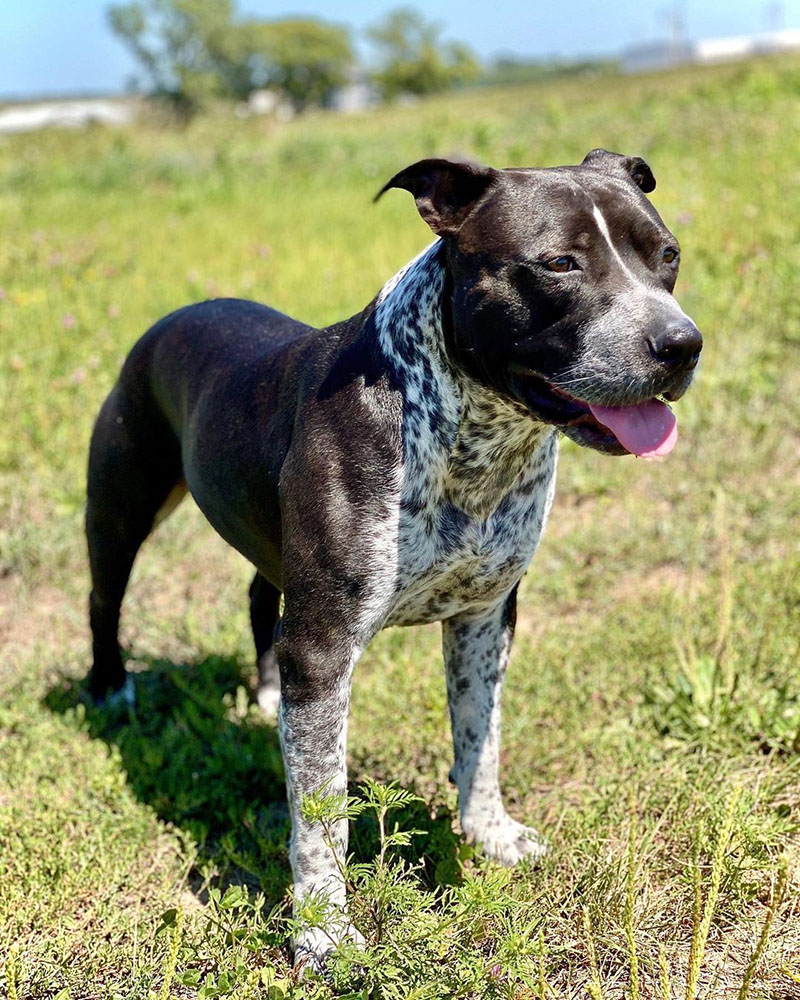
The “Pitbull Heeler” is an athletic, energetic dog suitable for any active family unit, though it doesn’t do well in extreme heat due to its thick double coat. This medium-sized mix is a relatively new designer breed that hasn’t been around that long.
Our guide will take you through the histories, temperaments, popularity and utility of their parent breeds, to give you a better idea of why one might want a Blue Heeler Pitbull in their lives!
Pitbull Blue Heeler Mix – At a Glance
| Weight: | 30 – 60 pounds |
| Height: | 17 – 24 inches |
| Lifespan: | 12 – 15 years |
| Coat Colors: | White, grey, brown with blue mottled, or striped finish |
| Temperament: | Hardworking, headstrong, loving, loyal, eager to please |
| Most Suitable For: | Active families, active single individuals, not suitable for the elderly |
What Does a Pitbull Blue Heeler Mix Look Like?
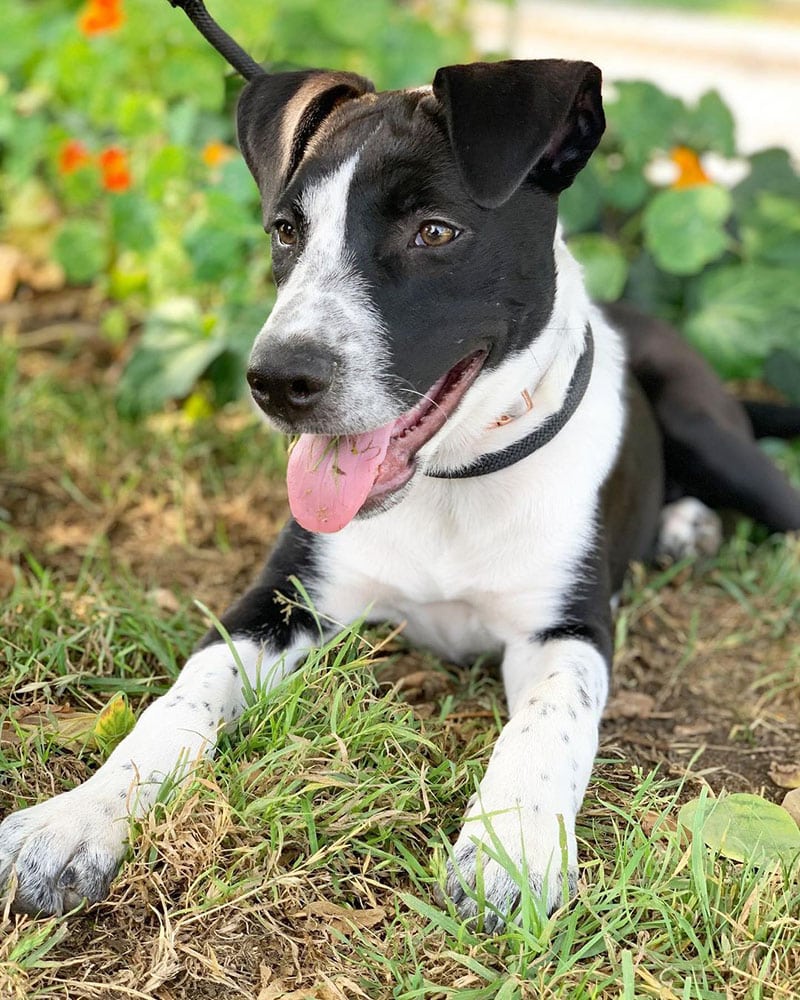
The Blue Heeler Pitbull mix will be a medium-sized dog that will borrow different parts of its physical appearance from both parent breeds. You can expect your “Queensland Pit” to give it another name to have a slightly longer, leaner body type than most traditional Pitbulls.
It will have a muscular chest and strong jawbones, along with either floppy, triangular ears or ears that are smaller and set back on their head. You can expect your Blue Heeler Pit mix to vary in coat colors, but always have black, white, or brown as a base color, with a mottled blue or brown stripe finish.
The solid white coat is a coat characteristic of the Australian Blue Heeler, as are double coats. You can expect your Heeler Pit to have a double coat that will shed moderately year-round and require a lot of grooming.
It is likely that your Blue Heeler Pitbull mix will have either solid brown eyes, or a mixture of brown and blue eyes, a condition known as heterochromia.
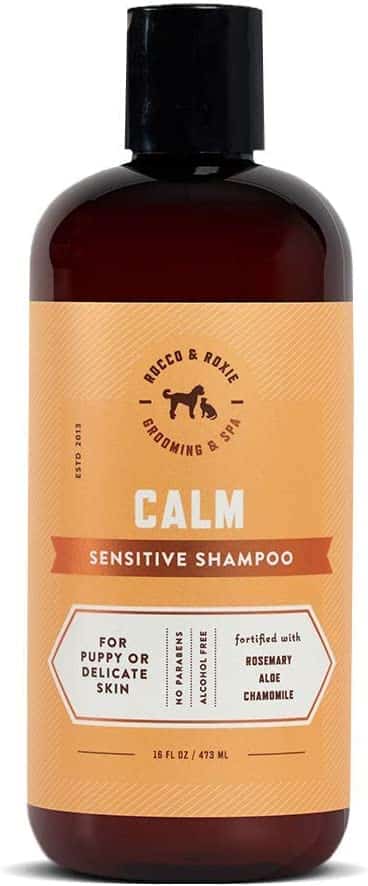
Rocco & Roxie Dog Shampoo
Buy Now Disclaimer – This website uses affiliate links and gets a small commission at no additional cost to you.Are you looking for a way to treat your furry friend? Sign up for our newsletter for a chance to win a free month of Barkbox!
The History of the Pitbull Blue Heeler Mix
As a mixed-breed dog, there’s not much history available about Pit Heelers, as the breed is relatively new to the mixed-breed landscape in the United States and the rest of the world.
Luckily, their parent breeds – the American Pit Bull Terrier and the Blue Heeler, known as the Australian Cattle Dog – have been around for a while. Thus we can glean information about them to form a knowledge base for the Blue Heeler Pitbull.
The History of the Blue Heeler
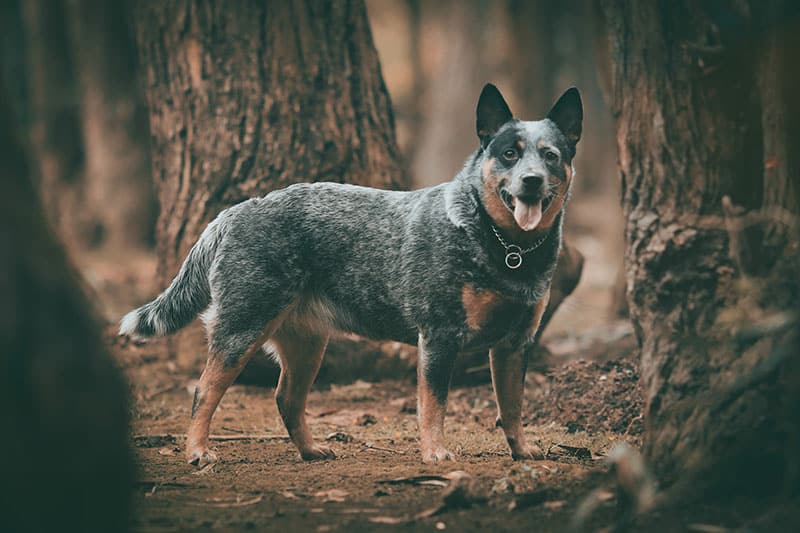
The Australian Cattle Dog, more commonly referred to as the “Blue Heeler” was a breed created in Australia in the early 19th century by George Hall. George Hall was a cattle herder who needed a dog capable of herding cattle from the pastures in Queensland, to the Sydney market – a journey of thousands of kilometres across unfenced cattle tracks.
After losing hundreds of cattle along the route, Hall realised that he needed a healthy breed of dog that had boundless energy to keep his cattle in check. He began importing Old English Sheepdogs and crossbreeding them with wild Dingoes to create “Hall’s Heelers.” These dogs were named “Heelers” as they would nip at the heels of the cattle to keep them in line.
The Australian Heeler is still used as a herding breed to this day in parts of Australia and has been exported to the United States, United Kingdom and Canada, where they are both working dogs and family pets.
How Popular Are Blue Heeler in the United States?
Australian Heelers were exported to the United States in the 1940s by a combination of Australians migrating to the U.S. and American soldiers returning home from being stationed in Queensland.
They continued to be used as cattle dogs and were supremely useful to farmers during their initial years in the country, but today, they are used as police dogs and therapy dogs.
In 2021, the Australian Cattle Dog ranked as the 51st most-popular dog in the United States.
Who Are Blue Heeler a Good Dog For?
Australian Cattle Dogs are dogs with very high energy levels that require plenty of exercises. They do much better with a house and yard to roam in than an apartment.
Their overall energy and exercise requirements make them ideal for active families but not for the elderly or owners without the time to exercise regularly.
How Did Blue Heeler Come About?
George Hall, an English migrant to Australia in the 18th century, first created the Blue Heeler. He began importing Old English Sheepdogs to Australia and crossbreeding them with wild Dingoes to create the modern Blue Heeler.
When Did We First Cross-Breed The Blue Heeler?
The Australian Cattle Dog is reasonably popular in the United States as a crossbreed dog, given their athleticism, agility, and utilitarian nature.
Some popular crossbreeds of the Blue Heeler include:
- Corgi Blue Heeler Mix (Corgi Heeler)
- Chihuahua Blue Heeler Mix (Chi Heeler)
- Siberian Husky Blue Heeler Mix (Husky Heeler)
- Labrador Blue Heeler Mix (Labraheeler)
- Blue Heeler Dalmatian Mix (Dalmaheeler)
The History of the Pitbull
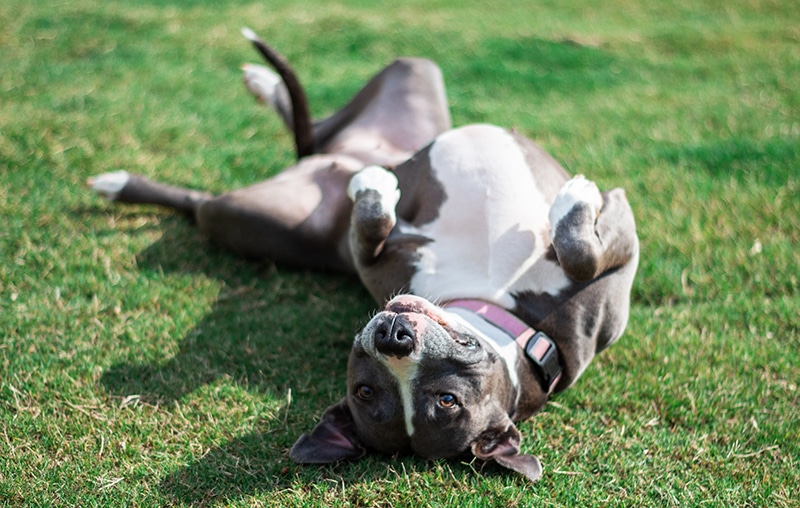
The Pitbull – or the American Pitbull Terrier has a long and storied history inside the United States. However, before it entered the United States between 1845 and 1860, it was utilized in England as a ‘bull-baiting’ dog. This blood sport was one of the country’s most popular ‘sports’ during the late 18th and early 19th centuries.
Bull-baiting used Pitbulls and other terrier-type dogs inside a field with an angry bull cow until either the dog was killed or the cow collapsed from exhaustion. This became very popular with the populace and was one of the primary reasons for breeding dogs like the English Bulldog and Boxer breeds.
In 1835, the Cruelty Against Animals Act outlawed ‘bull-baiting’ and Pitbulls almost immediately lost popularity in the United Kingdom and were imported to the United States. There, Pitbulls began a new life and became popular reasonably quickly.
However, unfortunately, the American Pitbull Terrier’s reputation for aggression has led to widespread outlawing across American cities – though no American states outlaw Pitbulls entirely, several major American cities have various legislation restricting Pitbull ownership.
How Popular Are Pitbulls in the United States?
Unfortunately, the American Kennel Club doesn’t recognize the Pitbull as a breed, due to it’s murky legal status in the United States. However, the American Pitbull Terrier is recognized by the United Kennel Club.
Other statistics state that the American Pit Bull Terrier account for 20% of all ‘strong dogs’ in the United States.
Who Are Pitbulls a Good Dog For?
Due to their stocky, muscular frame and powerful strength, the American Pit Bull Terrier isn’t a great option for elderly people, or those without the strength to control the Pitbull on a walk.
The American Pit Bull Terrier doesn’t do well in apartments and can suffer from separation anxiety, which can lead to destructive behavior.
How Did Pitbulls Come About?
Pitbulls were originally bred in the United Kingdom from the Old English Bulldog and Old English Terriers, where they were originally used as ‘bull-baiting’ dogs. However, when the practice was outlawed in 1835, Pitbulls were transported to the United States – sometime between 1845 and 1860.
When Did We First Cross-Breed The Pitbull?
The Pitbull is one of the most popular crossbreeds during the modern era, this is as a way to temper their hyperactive nature, along with tempering their boisterous temperament.
Some of the most popular Pitbull crosses are:
- Pitbull Shih Tzu Mix (Pit Shih)
- Pitbull Doberman Mix (Doberman Pit)
- Pitbull Catahoula Mix (Pitahoula)
- Pitbull Greyhound Mix (Grey Pit)
- Pitbull Yorkie Mix (Yorkie Pit)
How Important Is a Dog’s Temperament to Your Family?
One of the most important parts of your research proper to owning a dog is to do thorough research on the possible temperament of your prospective pup. If you are adopting or purchasing a mixed-breed dog, this is even more critical as you’re inheriting two different temperaments, and the result is likely a mixture of both temperaments.
Finding a dog that’s a temperamental match for you and your family is really important. You’ll need to make sure that your dog is able to meaningfully participate in the family activities, in order for them to feel included and lead a happy and healthy life.
If you’re a family that spends a lot of time outdoors, the last thing you want is to get a stay-at-home dog. Particularly if part of the reason you got a dog was to add to your family unit.
What is the Temperament of the Pitbull Blue Heeler Mix?
The Blue Heeler Pitbull mix, as a hybrid breed, will borrow heavily from both parent’s temperaments. You can expect an active, outdoorsy dog – as is the Cattle Dog’s nature – this will mean the need for daily exercise.
Your Blue Heeler Pitbull mix might express standoffishness with strangers. Harkening back to its Cattle Dog history. The Blue Heeler Pit mix loves nothing more than to be occupied! Giving it simple tasks to encourage mental stimulation is ideal for encouraging its intelligent side.
Is The Pitbull Blue Heeler Mix Friendly?
The Blue Heeler Pitbull mix is a relatively friendly dog! Very friendly towards family members and standoffish with strangers – until it warms to them.
You may also experience some hyperactivity around new people with the Blue Heeler Pitbull, this can be tempered with obedience training and positive reinforcement.
Is The Pitbull Blue Heeler Mix Easy to Train?
The Blue Heeler Pitbull is a reasonably easy dog to train. While the Pitbull can be a little mischievous, the Australian Cattle Dog is used to following commands as a herding breed. This combination can produce a slightly more challenging dog, but it is trainable with time and patience.
How Much Can A Pitbull Blue Heeler Mix Weigh?
The average weight of a Blue Heeler Pitbull mix is between 30 and 60 pounds.
How Tall Can A Pitbull Blue Heeler Mix Get?
The average height of a Blue Heeler Pitbull is between 17 and 24 inches in height.
Similar-Sized Breeds
There are a few similar-sized breeds to the Pit Heeler. These include:
- Bohemian Shepherds
- English Bulldog
- Border Collie
- Chow Chow
Does the Pitbull Blue Heeler Mix Shed?
The Pitbull Blue Heeler is a minimal-shedding dog that will need to be brush once a week. Your Pit Heeler should be bathed around once every two weeks to a month, or as needed.
How Much Exercise Does A Pitbull Blue Heeler Mix Require?
The Pit Heeler is a very exercise-intensive breed, requiring plenty of outdoor exercise! Ideally, they require plenty of outdoor space to roam and run. It would be best if you prepared to walk your Blue Heeler Pitbull for about an hour daily.
How Long Can a Pitbull Blue Heeler Mix Live?
The average life expectancy of a Blue Heeler Pitbull mix is between 12 and 15 years.
What Health Conditions Could the Pitbull Blue Heeler Mix Have?
- Hip Dysplasia (Hip joint inflammation)
- Progressive retinal atrophy (Eye condition)
- Hypothyroidism (Thyroid issue that affects metabolism)
- Gastric Dilution-Volvulus (GDV) (Abdominal enlargement)
How Can You Find a Pitbull Blue Heeler Mix Puppy For Sale?
Before looking for a Blue Heeler Pitbull mix, consider adopting one first. Check out your local vet clinic or animal shelter to see if anyone has given up a Pitbull Blue Heeler for adoption.
If your search locally fails, you can check out AdoptAPet.com to see if there are any Blue Heeler Pitbulls available for adoption online.
How Much Does a Pitbull Blue Heeler Mix Puppy Cost?
The average cost of a Blue Heeler Pitbull is between $800 and $1200! This is roughly triple the cost of adoption.
However, if you’re to purchase a Blue Heeler Pitbull and have struck out in adoption options, please ensure that you shop responsibly by finding and working with a reputable breeder. We have created a guide to working with reputable breeders that you should read beforehand.
Is the Pitbull Blue Heeler Mix the Right Breed For You?
If you’ve been looking for an active, energetic mixed-breed dog that will keep you on your toes and outside!
If, however, you’re sure that the Pitbull Blue Heeler isn’t the right breed for you, check out our other breed guides to find a more suitable pup for your family.

